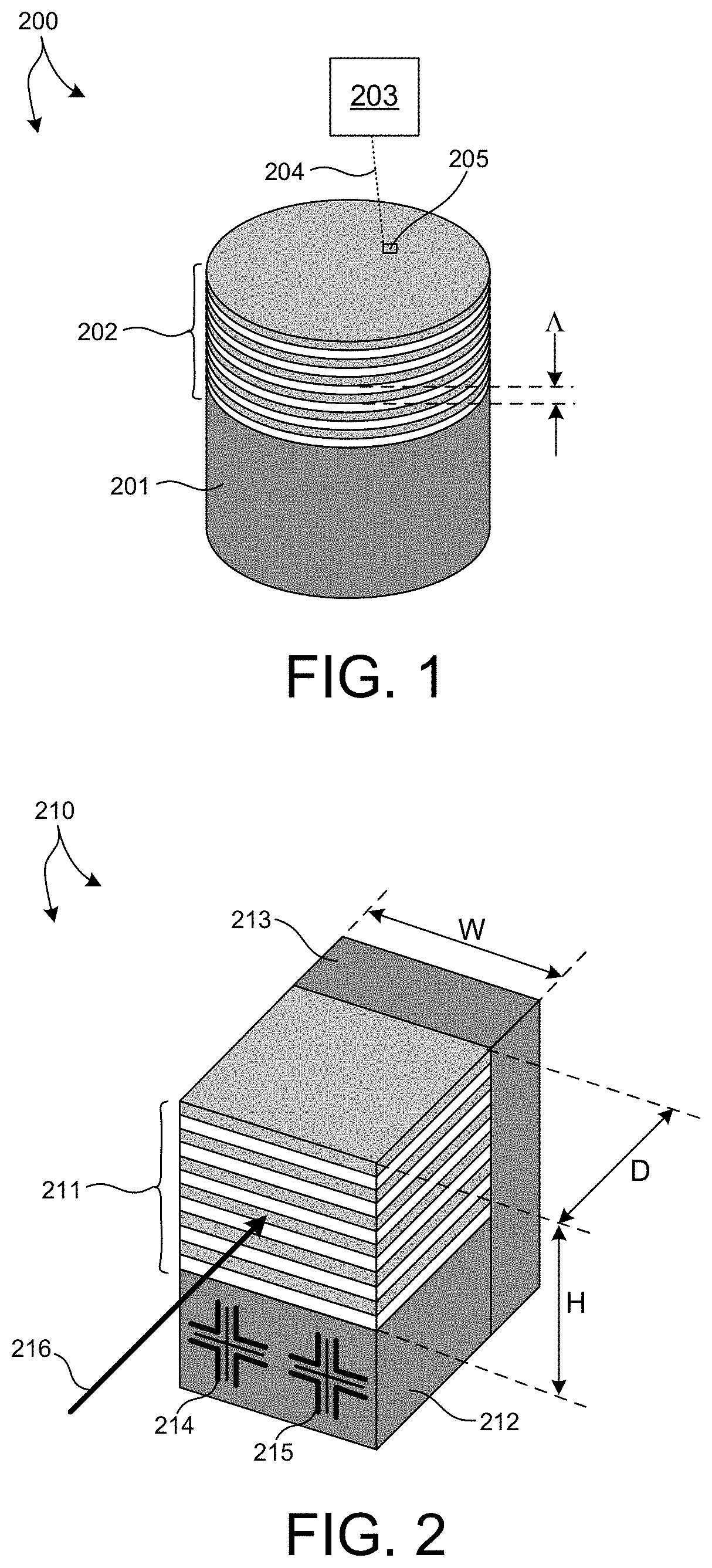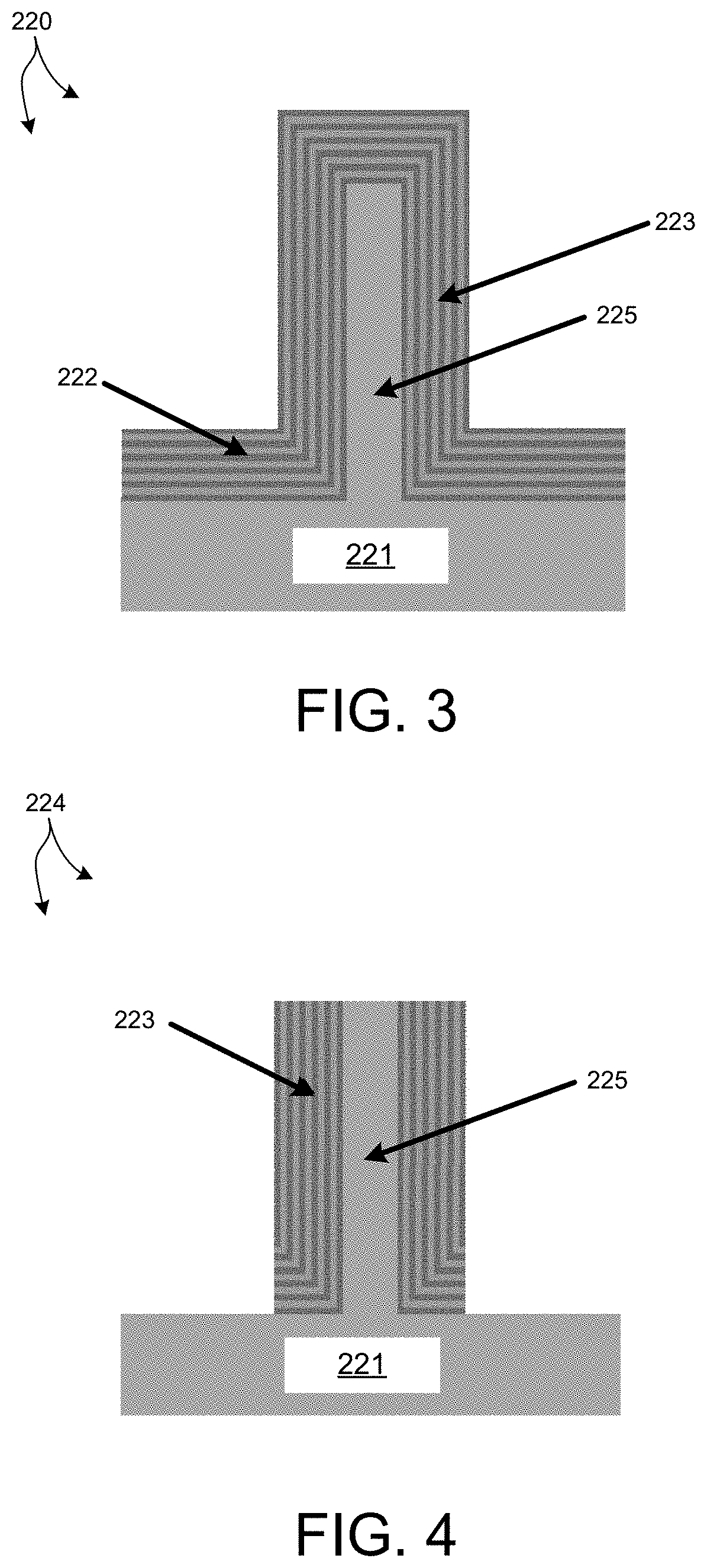As devices (e.g., logic and memory devices) move toward smaller nanometer-scale dimensions, characterization becomes more difficult.
Devices incorporating complex three-dimensional geometry and materials with diverse physical properties contribute to characterization difficulty.
For example, modern memory structures are often high-aspect ratio, three-dimensional structures that make it difficult for optical radiation to penetrate to the bottom layers.
Optical metrology tools utilizing infrared to visible light can penetrate many layers of translucent materials, but longer wavelengths that provide good depth of penetration do not provide sufficient sensitivity to small anomalies.
As a result, the parameters characterizing the target often cannot be reliably decoupled with available measurements.
However, the mirror like structure of 3D FLASH intrinsically causes decreasing light intensity as the illumination propagates deeper into the film stack.
This causes sensitivity loss and correlation issues at depth.
In this scenario, SCD is only able to successfully extract a reduced set of metrology dimensions with high sensitivity and low correlation.
Optical radiation is often unable to penetrate layers constructed of these materials.
As a result, measurements with thin-film scatterometry tools such as ellipsometers or reflectometers are becoming increasingly challenging.
However, these approaches have not reliably overcome fundamental challenges associated with measurement of many advanced targets (e.g., complex 3D structures, structures smaller than 10 nm, structures employing opaque materials) and measurement applications (e.g., line edge roughness and line width roughness measurements).
Atomic force microscopes (AFM) and scanning-tunneling microscopes (STM) are able to achieve atomic resolution, but they can only probe the surface of the specimen.
In addition, AFM and STM microscopes require long scanning times. Scanning electron microscopes (SEM) achieve intermediate resolution levels, but are unable to penetrate structures to sufficient depth.
Thus, high-aspect ratio holes are not characterized well.
In addition, the required charging of the specimen has an adverse effect on imaging performance.
X-ray reflectometers also suffer from penetration issues that limit their effectiveness when measuring high aspect ratio structures.
For example, transmission electron microscopes (TEM) achieve high resolution levels and are able to probe arbitrary depths, but TEM requires destructive sectioning of the specimen.
But, these techniques require sample destruction and lengthy process times. The complexity and time to complete these types of measurements introduces large inaccuracies due to drift of etching and metrology steps.
In addition, these techniques require numerous iterations which introduce registration errors.
Most research groups have employed high-brightness X-ray synchrotron sources which are not suitable for use in a semiconductor fabrication facility due to their immense size, cost, etc.
Current techniques for calibration and alignment of SAXS tools suffer from very long measurement times and their accuracy strongly depends on the accuracy of prepared targets.
Alignment time can be lengthy if the number of required measurement iterations becomes excessive.
In addition, accuracy is limited by the semi-transparency of the knife edge and also strongly depends on manufacturing accuracy of the knife edge.
Characterization of an X-ray beam with traditional knife edges is complicated due to the semi-transparency of the knife material illuminated by X-ray radiation near the edges of the knife edge.
This simple estimate of the uncertainty of a knife edge position during an X-ray beam scan illustrates that when the required alignment accuracy is less than a few micrometers (e.g., less than 10 micrometers), the semi-transparency of the knife edge is limiting.
Unfortunately, errors associated with transferring the measured coordinates from the X-ray camera to the optical microscope are significant and exceed the required accuracy of navigation.
Furthermore, characterization of the X-ray beam by an X-ray camera or knife edges are intrinsically indirect and do not provide quantitative data on photon flux incident on the target as well as photon contamination of neighboring regions.
Diffraction targets manufactured by traditional semiconductor fabrication techniques suffer from low contrast.
In addition, fabrication lead times are usually very long and costly.
A wafer including many targets is very expensive, and any change in target design or target parameter values requires another expensive and long lead time purchase.
Unfortunately, silver behenate targets require very long exposure times and can only be used to perform sample-to-detector distance measurements.
To reduce exposure time, a thicker sample must be used, which increases uncertainty of the distance measurement.
Future metrology applications present challenges for metrology due to increasingly small resolution requirements, multi-parameter correlation, increasingly complex geometric structures including high aspect ratio structures, and increasing use of opaque materials.
Existing methods of X-ray tool alignment and target navigation are limited to an accuracy of approximately 10-20 micrometers.
These methods are not able to position and measure metrology targets of small sizes (−50 micrometers) in an X-ray beam with sufficient accuracy for semiconductor metrology applications.
 Login to View More
Login to View More 


